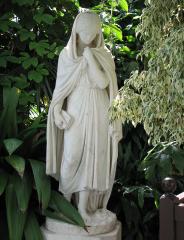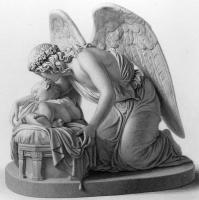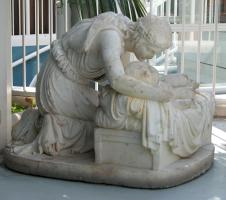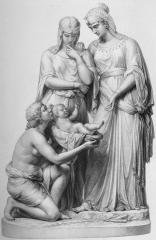Benjamin Edward Spence (1822–1866)
The Victorian sculptor Benjamin E. Spence made a series of rather sweet, rather sentimental statues of girls in pure white marble, several of which were reproduced in Parian porcelain, and it is through these small figures that his work is probably most familiar.
B.E. Spence statue of Highland Mary.
The sculptor B.E. Spence was a native of Liverpool, son of William Spence, a one time monumental sculptor who abandoned art for business. He was something of a prodigy, achieving early note with a bust of his Liverpool patron, William Roscoe. From about 1838 he studied in the Liverpool Academy Schools, before travelling to Rome at the behest of the important sculptor John Gibson, where he also worked in the atelier of Richard James Wyatt. Although Spence had exhibited regularly with the Liverpool Academy, and sent a version of Death of the Duke of York at Agincourt to Westminster Hall in London in 1844, he only showed five works at the Royal Academy: a portrait bust in 1849, and four pieces from ancient mythology between 1850 and 1866, including his popular ‘Ophelia’ and ‘Venus and Cupid’. He also made the allegorical statue representing Liverpool for the Crystal Palace. He stayed in Rome, in the Via del’ Incurabile, afterwards marrying the daughter of the British consul to the city of Livorno, and from whence he visited England once a year. He died at just 43 years old.
B.E. Spence's The Angel's Whisper, then and now.
Spence’s oeuvre consists of a few portrait busts and statues, two or three church monuments, a few male figures from mythology, and a goodly number of statues of girls, mostly either from Greek mythology again, or allegorical, with the odd religious or literary figure. Several of his works may be found in his native city of Liverpool, His best known work is Highland Mary (after a romantic poem by Burns), which may be seen in the Palm House, Sefton Park, along with The Angel’s Whisper. A second version of Highland Mary is in the Walker Art Gallery, together with a charming Psyche at the Well, seminude, with little wings. A rare male statue by Spence, also in Liverpool, is that of Jonathan Brooks, Archdeacon of Liverpool, in St George’s Hall; statues by Spence were on the exterior of the Picton Library, but have been removed. Copies of some of his works are in the collection of University College London. In Leeds is a small monument by him, a wall plaque with a small profile of James Marshall (d. 1855), in the Parish Church. The Art Journal had a penchant for his works and engraved several of them.
Spence was best known for a series of statues of rather sweet girls, in white marble, all rather similar, typically with short hair and round faces in the style of the first part of the 19th century, head inclined demurely. They are generally nicely draped, or semi-draped, in a figure-hugging classical manner. Several of his works were made in several versions, including maquette scale. They resemble indeed the work of his masters, John Gibson and R.J. Wyatt, but softer, more sentimental, perhaps a little too much so for later artistic taste.



